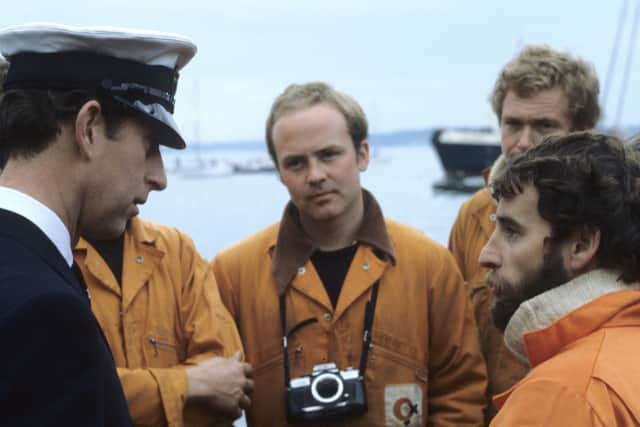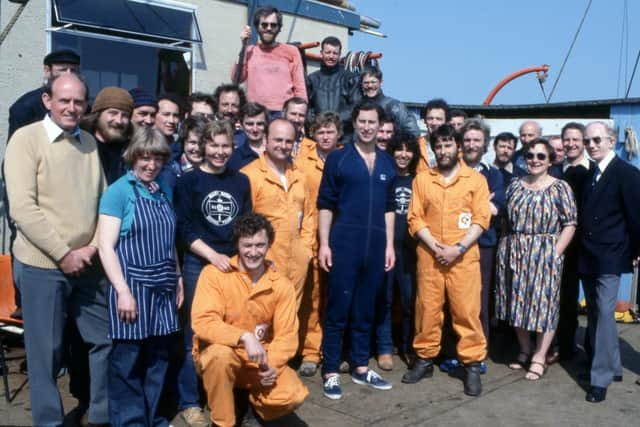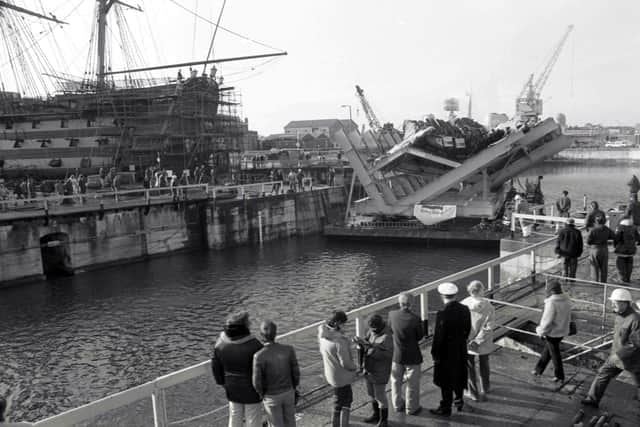Sunken Tudor warship The Mary Rose is raised from her watery grave (1982)
and live on Freeview channel 276
Nerves strained by days of delay and problems, almost snapped when the lifting steel frame, tilted as the ship hung above the Solent, but the accident only seemed to have shivered the timbers of the pride of Henry VIII's navy.
The Mary Rose Trust's archaeological director, Mrs Margaret Rule, burst into tears of joy after days of what she described as “heart-stopping moments”.
Advertisement
Hide AdAdvertisement
Hide AdFor her it was the vindication of her painstaking approach to the £4 million recovery project. As a cannon was fired from the ramparts of Southsea Castle and an armada of small boats sounded their sirens, she said: “I am just so overjoyed that we have got this far. She was ours when she was down there. Now she belongs to everybody.”


Prince Charles was one of the nearest to the frame around the Mary Rose when part of it collapsed.
He confessed later: “I was slightly horrified but I thought the best thing to do was to be British and not panic.”
He described the Mary Rose project as a marvellous achievement but also spoke of the difficulties encountered, particularly in the last few days.
Advertisement
Hide AdAdvertisement
Hide Ad“Being a charitable operation it is difficult to have the standby or fallback systems which this sort of crane operation would have normally. We have got enough money to do that, so we have to be enormously careful.”


He said he hoped the Mary Rose and the Victory would form the centrepiece of a maritime museum in Portsmouth.
He said the Mary Rose would provide a “doll's house view” of the ship.
“It makes history much more fun and alive if you can see and almost touch the actual exhibits.”
Advertisement
Hide AdAdvertisement
Hide AdHe spoke of his future role in the Mary Rose Trust. He said: “We have got to make sure that everything is organised to keep the whole thing going. The great problem is money and how you can organise to raise more.”


For Alexander McKee the raising of the Mary Rose is the fulfilment of a 20 year dream.
He had first started asking questions about the whereabouts of the Tudor warship in 1962, and had become convinced that she lay, still partially intact, buried deep, in the mud of the Solent at a spot a mile off Southsea.
He was described as a man obsessed with an idea that would come to nothing.
Advertisement
Hide AdAdvertisement
Hide AdBut with other divers he descended into the depths, 45 feet beneath the waves, to prove them wrong. They found the Mary Rose buried in the mud where she had lain for more than 400 years.
Historian McKee, 64, had just returned from diving on a wreck in the Mediterranean, used to live on the Isle of Wight.
In the family library there was a book which mentioned the battle, in 1545, when the Mary Rose sank.
The story fascinated him. He said: “She was obviously the most important known wreck in North West Europe.” And he added that he believed, the Mary Rose could still be, found, her timbers preserved by the clay and mud of the Solent.
Advertisement
Hide AdAdvertisement
Hide AdThe diving work to locate the wreck was often dangerous. Modern-day warships passed overheadin and out of Portsmouth Dockyard.
“We were forced to take risks, to take it right to the edge,” he said.
“On the first dive I had four destroyers over me, then the Isle of Wight ferries and so on. My wife there was afraid I would get killed. The Mary Rose was a rival to the wives and girlfriends.
McKee had been obstinate in his determination to prove he was right, and recalled the wonderful moment when, in 1970, they found a gun from the Mary Rose, proof indeed that she was there.
Advertisement
Hide AdAdvertisement
Hide Ad“The recovery of King Henry VIII's flagship, Mary Rose, from the waters of the Solent 437 years after she sank was not only an outstanding salvage undertaking but a chapter of archaeological history which the country was privileged to watch, fascinated and thrilled,” declared an editorial in the News Letter.
“More than that. It brought home the advances that have been made in scientific development over the past 400 years.”
It asked: “What would that remarkable monarch have thought if he had been a spectator yesterday? In a helicopter or in a wet suit?”
“But if the operation epitomised the progress of the past 400 years what of its heights – and depths - in the 400 years to come?”